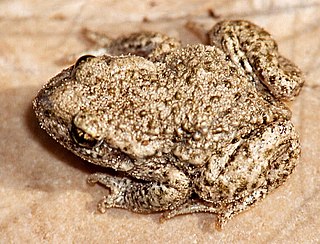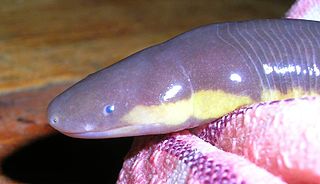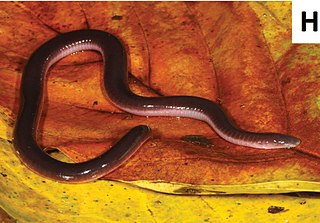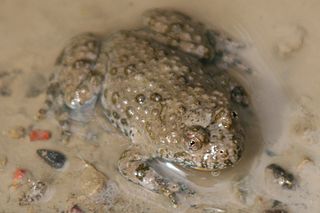
The tailed frogs are two species of frogs in the genus Ascaphus, the only taxon in the family Ascaphidae. The "tail" in the name is actually an extension of the male cloaca. The tail is one of two distinctive anatomical features adapting the species to life in fast-flowing streams. These are the only North American frog species that reproduce by internal fertilization. They are among the most primitive known families of frogs.

Leiopelma is a genus of New Zealand primitive frogs, belonging to the suborder Archaeobatrachia. It is the only genus in the monotypic family Leiopelmatidae. The leiopelmatids' relatively basal form indicates they have an ancient lineage. While some taxonomists have suggested combining the North American frogs of the genus Ascaphus in the family Ascaphidae with the New Zealand frogs of the genus Leiopelma in the family Leiopelmatidae, the current consensus is that these two groups constitute two separate families. The four extant species of Leiopelmatidae are only found in New Zealand.

The Alytidae are a family of primitive frogs. Their common name is painted frogs or midwife toads. Most are endemic to Europe, but three species occur in northwest Africa, and a species formerly thought to be extinct is found in Israel.

Archaeobatrachia is a suborder of the order Anura containing various primitive frogs and toads. As the name suggests, these are the most primitive frogs. Many of the species show certain physiological characteristics which are not present in other frogs and toads, thus giving rise to this group. They are largely found in Eurasia, New Zealand, the Philippines, and Borneo, and are characteristically small. In addition, the family Ascaphidae is found in the Pacific Northwest and northern Rocky Mountains of the United States, and is only represented by two species. The taxon is considered paraphyletic.

The Mesobatrachia is a paraphyletic group of relatively primitive frogs. At the end of 2016, it contained 3 superfamilies, 6 families, 16 genera, and 244 species. Recognized as a group in 1993, the name is contrasted with the primitive Archaeobatrachia and the more diverse and advanced Neobatrachia.

The Neobatrachia are a suborder of the Anura, the order of frogs and toads.

Rhinatrematidae is a family of caecilians, also known as the Neotropical tailed caecilians, American tailed caecilians. or beaked caecilians. They are found in the equatorial countries of South America.

The Ichthyophiidae are the family of Asiatic tailed caecilians or fish caecilians found in South and Southeast Asia as well as southernmost China.

The Scolecomorphidae are a family of caecilians also known as tropical caecilians, buried-eyed caecilians, or African caecilians. They are found in Cameroon in West Africa, and Malawi and Tanzania in East Africa. Caecilians are legless amphibians which superficially resemble worms or snakes.

Caeciliidae is the family of common caecilians. They are found in Central and South America. Like other caecilians, they superficially resemble worms or snakes.

The fire-bellied toads are a group of six species of small frogs belonging to the genus Bombina.

The Pipidae are a family of primitive, tongueless frogs. There are 41 species in the family, found in tropical South America and sub-Saharan Africa.

The European spadefoot toads are a family of frogs, the Pelobatidae, with only one extant genus Pelobates, containing six species. They are native to Europe, the Mediterranean, northwestern Africa, and western Asia.

The European fire-bellied toad is a species of fire-bellied toad native to eastern parts of mainland Europe, where it can be found near waterbodies such as ponds and marshes. It is known for its red colored belly used to ward off predators, an example of aposematism, and its distinctive "whoop" call.

The yellow-bellied toad belongs to the order Anura, the archaeobatrachial family Bombinatoridae, and the genus of fire-bellied toads. The toad is distributed mainly across western Europe as well as a handful of countries in eastern Europe. While the population of the toad is steadily decreasing over time, its numbers are not critical enough to be considered threatened or extinct. Conservation efforts in Germany are taking place to remedy the declining population before it is too late.

The Oriental fire-bellied toad is a small semiaquatic frog species found in northeastern Asia, where they primarily dwell in slow-moving bodies of water and temperate forests. Quite common throughout much of their range, these frogs have mild toxins that can be excreted through their skin, with their vibrant underbellies serving as a warning of this. While not a true toad, their green and black skin is covered in small tubercles, giving them a toadlike appearance. Their sounds, mainly produced by males during the mating season, are very unlike those of other frogs. While their population is in decline, their numbers are still high overall, with the International Union for Conservation of Nature (IUCN) rating them as a least-concern species. They are commonly kept as pets in land and water vivaria, as a relatively easy-to-care for species. They are also frequently used in scientific research, with their behavior, vocalizations, and learning skills all moderately studied.

Barbourula busuangensis is a species of frog in the family Bombinatoridae. It is also known under the common names Philippine flat-headed frog, Palawan flat-headed frog, Busuanga jungle toad, Busuanga disk-tongued toad, and Philippine aquatic frog. It is endemic to the Busuanga, Culion, Balabac, and Palawan islands in the Philippines. It is an inhabitant of clear-water streams and is threatened by habitat loss.

The Bornean flat-headed frog is a species of frog in the family Bombinatoridae. Although many salamanders are lungless, the Bornean flat-headed frog is the first frog known to have no lungs.
Bombina maxima, commonly known as the Yunnan firebelly toad or large-webbed bell toad, is a species of toad in the family Bombinatoridae found in Yunnan, China and likely to Myanmar. Its natural habitats include swamps, springs, marshes, arable land, canals, and ditches. Although easy to care for, handling a large-webbed toad should be kept to a minimum because their skin secretes a toxin that can cause irritation





















